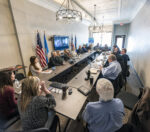

“The Chamber is excited to announce that we will be bringing back ‘CART’ in 2023.” That was the opening line of a note in the Aberdeen Area Chamber of Commerce’s weekly announcements emails to members in late 2022.
What is CART? Why did it start? Why did it go away? Why did it come back? And why should you care?
A few people who frequently participated over the years described the 30-year Aberdeen institution and its purpose.
“Rapid response on key community issues” was a main focus identified by Julie Johnson, former South Dakota Secretary of Labor. She added that in CART, one found “All the right people at the table so immediate action can be taken.”
Kelly Weaver, then with Northeast Council of Governments and current Small Business Development Center Regional Director, believed, “It served as a way for people from all parts of the community to gather and share ideas for new projects, to address other issues facing the community.”
Tom Agnitsch, retired CEO of the United Way of Northeastern South Dakota, said, “People in the community volunteered and offered suggestions as to what we needed to tackle.
Beth Smith, then area director for U.S. Senator Tom Daschle, identified several important aspects: “Keeping the lines of communication of civic, county, state and federal government open. Building a network with those entities as well as corporate, banking, retail, ag, healthcare, nonprofits, higher education.”
Your friendly author began attending CART in the early 2000s. On the younger end of the age range in the room at that time and faced with the choice of sitting at the Chamber’s conference table or in the chairs against the wall, I typically chose the wall—the kids’ table. Even from there, I recognized interest and passion for the community at the “adults’ table” that was inspiring.
A kitchen cabinet of sorts (like all cabinets, unelected), although with no specific head chef, CART was a versatile, flexible, sometimes interchangeable group dedicated to bettering Aberdeen. It might be too much to say CART was the heart or brain of Aberdeen—maybe its frontal lobes concerned with problem solving and judgment. At the same time, it tended to have its finger on Aberdeen’s pulse.
More concretely, former Executive Vice President of the Aberdeen Development Corporation James Barringer focused on CART’s “assistance through a community-wide effort to mitigate the job losses resulting from the closure of the Control Data plant.” That was a big load.
WHY CART?
Barringer’s comment gets at how and why such a group assembled. In late 1988, Imprimis, a subsidiary of the Control Data corporation and one of Aberdeen’s largest employers, abruptly announced that it would close by mid-1989 if no buyer for its local plant could be found. The threat of shutting down the nearly 20-year employer threw more than 750 full-time workers and their families into uncertainty.
Hoping to use some visible hands to influence invisible market forces, Mayor Tim Rich quickly called together people from across the community to respond. “I proposed getting people from the colleges, banking, law, government, and other areas to meet every week to address the problem and attract businesses to fill the need,” Rich said. For him, the overall purpose of what became CART was “to produce good jobs with good benefits and good pay—like 3M offered”—jobs that would allow “people to get married, have a family, and stay in Aberdeen.”
Many people accepted the burden of that load. Several committees were formed to address the situation, and a core group began meeting at the Chamber offices to coordinate efforts. While Rich was the nominal chair of the group, he induced Super 8 CEO Dennis Bale to lead the special project of working with Control Data to mitigate the impact on the employees and the community and coordinate the sale of the plant.
Sharon Stroschein, then Northeast Area Director for U.S. Representative and later Senator Tim Johnson, said, “After we got a chance to catch our breath after the sudden closing of the plant with hundreds of people out of work almost overnight, we decided to call our group the Community Action Response Team”—aka CART.
Recovering from the job losses was the main focus, said Jeff Mitchell, then Director of the Aberdeen Area Career Planning Center (AACPC), who noted the creation of “the Social Impact committee, which developed the first job fairs, later Career Days.” The AACPC was very involved in reemployment efforts. “We were the point of entry into the Department of Labor’s dislocated worker program.”
On point, “I was able to bring certain resources to the table,” then-Labor Secretary Johnson noted, and CART was “able to deploy information across the community quickly to take care of people.”
Mitchell agreed, “Many people were able to access re-education/training programs and actually move into better paying, career-focused employment in and around Aberdeen.”
Aberdeen Job Service Manager at the time Kae McNeil noted, “The work component of unemployment insurance was temporarily adjusted because of the large number of people looking for work.” In addition, the CART-supported “Recruitment of other businesses matched to the education and training of workers available in the workforce.” She added, “Leaders from Northern State University, Presentation College, and Aberdeen Public Schools participated in discussions about developing training associated with Federal job training monies which were available for displaced workers.”
On the whole, the response, as driven by the CART group, helped get the community and the displaced workers through the crisis. In addition to former Imprimis employees finding work, the building was leased out. “It was a big building,” Rich noted. “We split it into two spaces and got Sheldahl, which made circuit boards for auto dashboards, and Banner Engineering to take leases.”
“For the Control Data response, it was a great display of leaders working together,” Weaver observed of CART. “The community also benefited from other projects that were brought to the table and ultimately implemented.”
FURTHER ON UP THE ROAD
Indeed. As Barringer noted, “We recruited multiple companies to Aberdeen in 1989 and as a consequence it was awarded Community of the Year by Governor Mickelson.” Besides Sheldahl and Banner, over time, these new companies included Aberdeen Machine Tool, United Defense, Midcom, Mutual of Omaha, and others.
Even though they’d weathered the Imprimis closing, CART continued to meet every Thursday morning to discuss community and regional issues and transformed into the “Community Action Resource Team.” Through the years, says the Chamber history, “CART continued to be a ‘clearinghouse’ where ideas, some proven to be good and some rather quickly deemed to be of little value, are brought forward and discussed.” The history added, wryly, “Some have called CART nothing more than a coffee club. Perhaps it is a coffee club that can take varying degrees of credit for some major accomplishments in our community and region.”
The people gathering around the table weren’t always the same, although there were many who attended frequently enough to be considered regulars. For some, it applied directly to their job. For others, it called on their interest in bettering their hometown. For all, it was about love of Aberdeen.
Barringer observed that CART acted on situations such as the Northern State College’s transition to university status, the west 281 bypass, and regional economic development, such as the ethanol plant in Mina. Agnitsch noted that CART also focused on beautification and “ways to clean up eyesores within the city.” Noting a project that is a point of pride for longtime CART members, former Dacotah Bank Marketing Vice President Paul McDonald remembered, “the late Helen Miller’s passion for a four-lane from I-29 to Aberdeen and points west and how she overcame Governor Janklow’s resistance.”
Stroschein said CART was crucial when “the wireless infrastructure in our region was expanded and improved to better serve current and future industry looking to locate in our region.” Mayor Rich added that this infrastructure “was about connectivity to the Internet for educational and medical needs.”
Few of these ideas originated there, Rich acknowledged, but “They went through CART. People talked about their projects at CART, and the folks there helped put pieces together.”
As a sounding board, CART had valuable benefits. “Early in my term, this was an opportunity to communicate my position regarding controversies and adversarial situations relating to my decisions,” former Mayor Mike Levsen observed. “As time passed, I was able to explain the strategy involved as we reversed decades-old City policy and embraced publicly financed projects,” such as the YMCA, the Boys and Girls Club, Safe Harbor, YMCA Youth Development Center, and more.
Not every idea came to fruition, nor did every discussion end in agreement. “Another project I remember being discussed at CART in later years was an event center at the fairgrounds,” Weaver recalled, adding dryly, “You can see where that went.” McDonald remembered “discussing employee recruitment concepts including reaching out to people around the world along the 46th parallel because they would relate to our four seasons vs. people from southern regions who would not stay once winter set in. No action was taken.” He added, “I remember bantering with leaders who considered $10 an hour ($12.50 an hour in today’s economy) as a primary earner’s wage. I clearly remember a leader declaring, ‘South Dakota is a cheap state to live in so we can get cheap labor so our business owners can enjoy above-national-average profit margins.’”
“The most significant person,” Levsen noted, “was Vi Stoia who always had the most incisive questions and contributed substance to the discussions.” Formally an insurance salesperson but so much more, Stoia “respectfully educated all of us through the benefit of his experience and perspective. Vi always stressed thinking regionally.” McDonald—who drove the creation of the Chamber’s Vitality Award honoring Stoia—added, “I remember Vi Stoia sitting at the west end of the Chamber conference table and listening to all the chatter for a half hour. Then when the loudest voices had had their say he would lean in and suggest wise and clear direction to the group.”
Besides what the community gained from CART’s work, participants gleaned some personal benefits as well. “I learned so much,” Stroschein said. “Many knowledgeable people attended weekly and gave reports on what their entity was doing to help the community.”
Gail Ochs, current Chamber President, gained “knowledge of the community, connections with leaders in the community, and shared concepts with the group.” McDonald “enjoyed the exchange of ideas by those who could make things happen.”
“It was very interesting to be plugged into the work the leaders of the community were doing and the topics of concern being addressed,” Weaver said. “I was just getting started in my career at the time so it was very educational and an opportunity to get to know many people doing great work in our community.”
Smith reported a perhaps unintended and unexpected result of CART—envy: “As I traveled around the state many community leaders asked me about CART and how it worked. It had a good reputation that other communities wished they had.”
ALL GOOD THINGS
But things come to an end. McDonald remembered, “the group dissolving when the city was no longer facing an emergency and those attending were merely looking for answers to their specific business category problems.” Others observed that after time the right players weren’t at the table. That absence had to include Vi Stoia, who died in 2008. As the Chamber’s email noted, CART’s “participation deteriorated.” The meetings came to an end a few years before COVID came to town.
Until now. Chamber president Ochs explained, “During our 2022 Planning Retreat, the Chamber Board of Directors and staff discussed various ways to re-engage with the community. It seems that since COVID hit there has been less in-person discussion and open communication on community topics. So, it seemed like the time was right to bring back CART for those who participated before and to engage and hear from new members of our community.”
So the Chamber sent out the message, “We believe now is the time to bring back this group to re-energize community discussion, awareness and engagement. It will be an opportunity to share useful information, learn about projects and ideas, generate discussion, and receive input.”
Since the beginning of the year, led by some people who were children or not even born during the founding of CART, a new generation has been gathering weekly—around a bigger table—to address community needs. The original group set a high bar, and fortunately, the new edition seems to have the same commitment to Aberdeen and willingness to carry the load. //
























